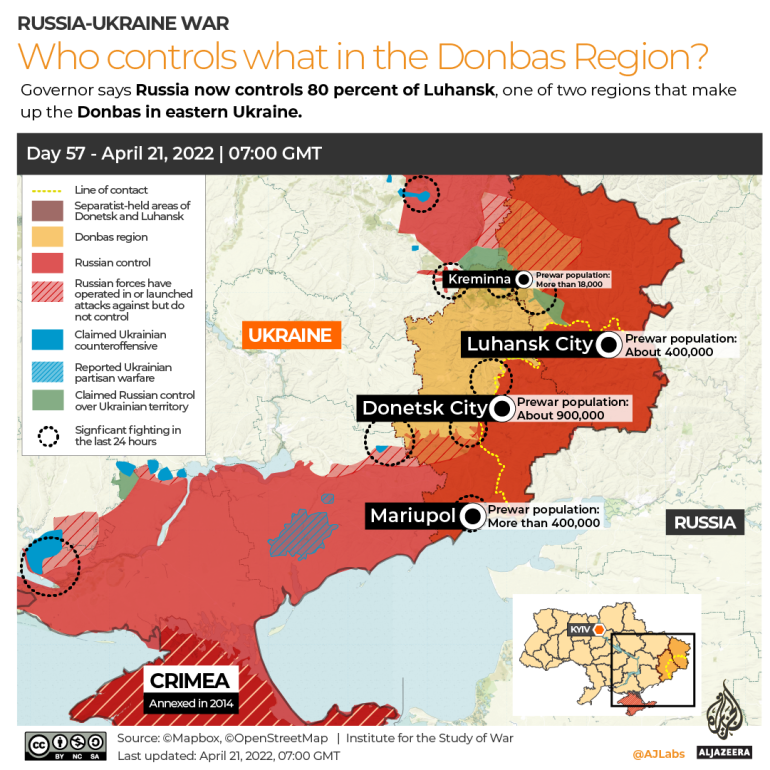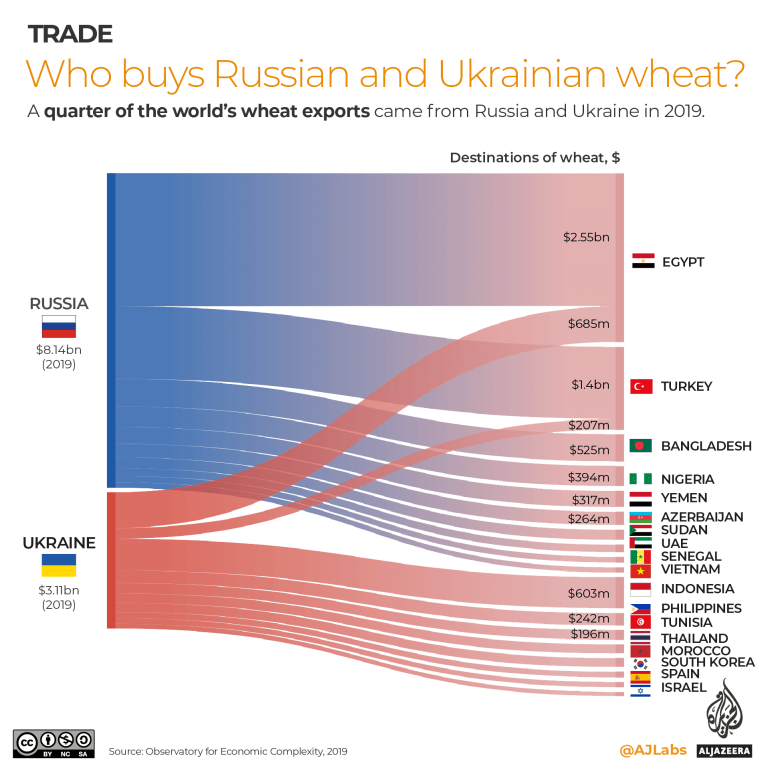Cutting Ukraine off from its most fertile land and main export hub will have long-term repercussions on global food exports, analysts say.
Russia’s invasion of Ukraine has sent food commodity prices soaring in March to the highest levels ever recorded, bringing to the forefront the global implications of its military offensive on the former breadbasket of the Soviet Union.
“There is no sufficient alternative to cover the gap,” Roman Slaston, director of the Ukrainian Agribusiness Club (UCAB), adding many countries in the world will be prone to “starvation, hunger riots, refugee migration without Ukraine’s food supply”.
Every second to third piece of bread in Africa and the Middle East is produced from Ukrainian wheat, according to the Global Hunger Index. Forty-seven countries had high levels of hunger in 2021 and the war in Ukraine is estimated to bring this number to more than 60 countries in 2022.
Ukrainian President Volodymyr Zelenskyy said Ukraine is not willing to give up territory in the eastern part of the country to end the war with Russia and is preparing to offer tough resistance.
Should it lose the regions of Luhansk, Donetsk, Zaporizka and Khersonska, where Russia has been advancing with the likely intent of securing a land bridge to the Crimean Peninsula seized in 2014, it would be deprived of almost one-quarter of its agricultural output, according to data collected by the US Department of Agriculture and compiled by Al Jazeera.

No ports, no exports
Moscow claimed last week that it seized the strategic port city of Mariupol, on the Azov Sea, a key export hub. It also took control of Kherson, a port city on the Black Sea and the Dnieper River, and is laying waste to the nearby Mykolaiv.
Even in port cities spared from the heaviest fighting, such as Odesa, Russian warships in the Black Sea have scared off commercial vessels.
“For instance, the export of sunflower seeds is now down to 15-20 percent of prewar levels,” Slaston said. “These quantities are insufficient to supply to the global market.”
A report by the United Nations’ Food Agriculture Organisation (FAO) described the “immediate food security dimension of this conflict” as being related to food access rather than food availability.
FAO economist Monika Tothova told Al Jazeera that 90 percent of commodity exports were going through ports in the Black Sea and the Azov Sea before the war.
“If Ukraine continues not to be able to export through the sea, this is going to put additional pressure on [global market] prices,” at least until other producers – including the European Union and India – can step up, she said.
FAO’s Food Price Index rose 12.6 percent in March compared with February, when it had already reached its highest level since its inception in 1990. The Cereal Price Index was 17.1 percent higher in March as a result of the war, while the Vegetable Oil Price rose 23.2 percent, driven by higher quotations for sunflower seed oil.
If Russia were to seize the breakaway provinces of Donetsk and Luhansk, which collectively account for 8 percent of the total agricultural output, the effect on food security would be limited, Tothova said.
“But if it also includes the areas that are important for shipping in the Black Sea ports, that will have a serious impact on the global markets,” the economist added.
A changing agricultural landscape
A Russian encroachment in the east, where most vegetable crops for domestic consumption are grown, is bound to change Ukraine’s agricultural landscape.
That is, she added, if Ukrainian farmers have enough fuel to power tractors, ploughs, combines and delivery trucks since most diesel came into Ukraine through Belarus, which is part of the assault, and Russia itself.
Compounding a precarious situation, Slaston said Russia is advancing on some of the richest soil in the world, known as “chernozems” or “black soil”.
According to the Fertilizers Price Index, its cost hit a record 128.1 percent increase compared with last year, after Moscow’s invasion soared energy prices and put a massive portion of the world’s supply at risk.
UCAB forecast this will reflect on the price of Ukraine’s spring crops, including grains such as barley and corn, as well as other crops such as sugar beet, sunflowers and soybeans.
“We hope these territories [in the east] are temporarily occupied and that we will be able to recapture that soon,” Slaston said.

‘Unspoken rewards of Putin’s invasion’
Some analysts have argued Ukraine’s valued “black soil” may have factored in the equation when Russian President Vladimir Putin decided to launch an invasion of Ukraine on February 24.
“There’s a real fear among agriculturalists that soil is being denuded of its nutrients and not replaced, and here you have in Ukraine some of the richest soil in the world, that is so fecund that is listed as a kind of a global heritage asset,” Ian Overton, director of London-based research group Action on Armed Violence, told Al Jazeera.
Studies have shown climate change is already having a negative impact on agricultural production in Russia, especially for products like grain that are most dependent on weather and climate factors.
Meanwhile, the former Soviet breadbasket was moving towards a historic land reform that pro-Russian voices in Ukraine fiercely opposed. In March 2020, the Ukrainian parliament cancelled a moratorium preventing the buying and selling of land but allowing long leases.
“Thanks to this historic decision, seven million Ukrainian landowners received the right to use their land at their own discretion,” Roman Leshchenko, who until last month served as Ukraine’s minister of agrarian policy, wrote last year in an opinion piece for the Atlantic Council.
While foreigners were still excluded from ownership, there were plans for a national referendum.
Occupying it militarily may impede further reforms, as well as provide some level of insurance against the kind of bread riots that ended centuries of czarist rule in Russia and shook authoritarian regimes across the Arab world.
“That, I think, is one of the great unspoken rewards of Putin’s invasion,” Overton said.















